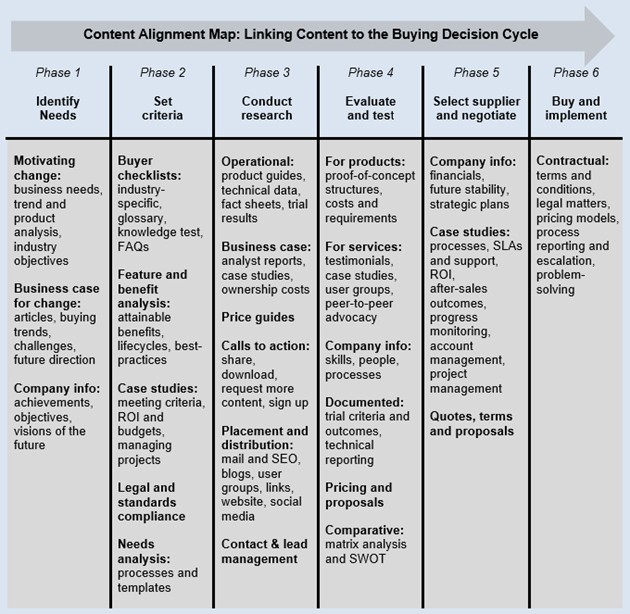In our B2B marketing guidebook Business-to-Business Marketing: A Step-by-Step Guide, published by Penguin Random House, my co-author Charlie Stewart and I write, "The purpose of B2B marketing is to attract and retain profitable customers."
In pursuit of that purpose, it is essential to win the sales-creating trust of everyone in your market who influences buying decisions, as I discussed in the first article of this series.
Here, in the second article, I offer guidance on how to win that trust:
- Get the right message to the right people at the right time in the buying decision cycle.
- Move the buying decision forward—from "we're interested" to "where do we sign?"
- Use influencer-based personas to guide the creation of relevant and credible content.
To attract and retain profitable customers, you have to play by the rules
The fundamental rules of B2B marketing are written in stone. They state that to convince customers to buy from you, they must know who you are, what you do, and why you matter—to them.
Back in 1958, the rules were emphasized in perhaps the most famous B2B advert of the 20th century. Known as The Man in the Chair, the print ad for McGraw-Hill's business, professional, and technical magazines detailed the questions that buyers expect suppliers to answer.
In recognition of the advert's undying significance—and to celebrate its 50th anniversary in 2008—the Business Marketing Association produced a video that demonstrated why the advert's message is still crucially relevant to marketers today:
For modern marketers seeking to attract and retain profitable customers, The Man's questions can be divided into a trio of simple categories—the three Ps:
- Purpose: Who are you?
- Process: What do you do?
- Promise: Why do you matter to me—the customer?
Nearly 60 years after the advert first appeared, customers still need to know how your organization will contribute to their success. They still need to know why your "Purpose, Process, and Promise" means they should buy from you.
Nothing has changed in terms of what you have to say to the market. Nothing. However, there has been a big change in how you can say it. We now have email, websites, online user groups, blogs, PDFs, e-books, video, interactive infographics, webinars, SlideShare, and social media.
With all these communications tools to work with—and surely more on the way—any company implementing a content marketing strategy should be laughing all the way to the bank. Sales should be rocketing and margins soaring.
But they're not. So what's gone wrong?
As marketers, what must we do to create sales, protect margins, and build market share?
Get the right message to the right people at the right time in the buying decision cycle
The following figure shows the six typical phases of the buying decision cycle, together with examples of the type of content that decision-influencers need during each phase.
In Phase 1, the decision-making process starts with the organization identifying a business need. The process ends at Phase 6, when the organization buy what's necessary to meet that need.

Move the buying decision forward—from 'we're interested' to 'where do we sign?'
To show how content relates to the cycle and to the different influencers it must address, here's a quick walk-through of the first three phases.
In phases 1 and 2, organizations identify needs and set criteria to meet them. They look for trusted insights into trends, opportunities, and threats, and they consider the implications of potential responses.
Developing such insights is usually a function of executives and senior managers. Your content should therefore address them in ways that demonstrate why you matter to them and prompt them to move forward with you.
In the third phase, organizations research solutions that will meet their needs and comply with their criteria. This task may be delegated to operational managers who need factual information about products, services, and the suppliers who might provide them. They need best-practice guides, case studies, product sheets, test reports, and endorsements. Once more, your content must engage these persons with information that addresses their specific concerns and requirements.
To create content that moves buyers toward signing on the dotted line, you should focus on how your products and services will contribute to the success of everyone who influences the buying decision.
To illustrate how you can do that, let's say a manufacturer of earthmovers claims durability makes a major contribution to customers' success. The company's content must therefore be credible in the ways it proves how they create durability. It must also prove why durability is relevant to everyone who influences the decision to buy earthmovers.
The manufacturer can't buy a box of durability and bolt it onto all its products. Durability stems from a variety of technical features incorporated in the earthmover. It's a result of the design, engineering, and consequent performance of things like the engine, suspension, transmission, and hydraulics, as well as adherence to standards that govern component-testing, manufacturing processes, and overall build quality.
All of that technical information forms the basis for creating credible content that says who they are—their Purpose, and what they do—their Process.
The next step for the manufacturer is to define their Promise, to communicate why their Purpose and Process are relevant—why they matter—to customers.
Promise-based content must prove that durability translates into benefits for each influencer.
Here are two simple examples of how that translation works: accountants need financial content that proves the promise of monetary benefits; engineers need technical content that proves the promise of operational benefits.
Use influencer-based personas to guide the creation of content that is credible and relevant
Personas that record each influencer's specific concerns are critical because they guide the process of producing content that will address those concerns and build sales-creating trust.
In addition to aligning it to the cycle and to the different influencers who feature in each phase, a powerful way to keep your content right on target is to ensure it conforms to three straightforward guidelines: It must be concentrated, convincing, and connected.
- Concentrated: A single focus on building sales-creating trust
- Convincing: Credible and relevant to every influencer in the buying decision cycle
- Connected: Moves the buying decision through the cycle, phase by phase
A word of warning about digital content marketing: beware 'packagists' and 'postmen'
"What you say in advertising is more important than how you say it." —David Ogilvy
A lot of the immense buzz about content marketing deals with the mechanics of providing content in formats that suit delivery across different digital channels. The emphasis is on the box in which content is packaged and how it gets posted/delivered.
In all of this talk about digital packaging and posting, the content of content is rarely mentioned.
If the "packagists" and "postmen" do mention what you need to be saying, it's often no more useful than suggesting you should be providing "quality content," "exceptional content," "amazing content," "compelling content," and "more content." Guidelines like that are not at all useful...
Although digitally based content marketing extends how you can communicate, it should not be an automatic swap-out for traditional print adverts, PR, and live events. And they might not be shiny and new, but TV and radio are still giants in the communications game.
Influencers within the cycle still read magazines, journals, newspapers, and brochure-ware. They still attend events, listen to the radio, and watch TV.
They are certainly not motivated to buy products and services because they like the box or how it's delivered. Not many of them look for information about steel fabrication on Facebook or gas turbines on Twitter.
It's the content in the box that matters. Exactly like it was back in '58, when The Man first sat in the chair.
* * *
In the next article, I'll discuss how the five factors of value drive B2B sales and protect margins.
Articles in this series:




